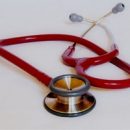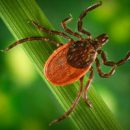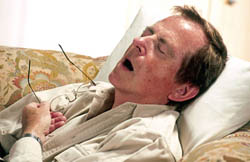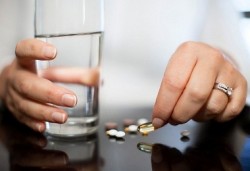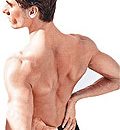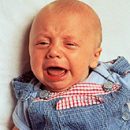How is the gymnastics after amputation? What exercises do? What gymnastics need to perform after prosthetics? Answers to these questions you will find in the article.
Content
Gymnastics after amputation
After amputation of the limbs, there is a restructuring of motor skills, compensatory adaptability develops, the possibilities of which are determined to a large extent force and endurance of the muscular system. In this regard, an important role is played by the LFC, both in the formation of a cult and in preparation for its primary prosthetics, and in teaching the use of prosthesis.
In the early postoperative period, therapeutic gymnastics is aimed at the prevention of postoperative complications, improving blood circulation in a cult, stimulation of regeneration processes, prevention of pronounced muscle atrophy and reduce pain. Contraindications for the purpose of therapeutic gymnastics: acute inflammatory diseases of the cult, the general severe condition of the patient, the high body temperature, the danger of bleeding and other complications.
From the 2-3rd day after amputation, overtaking exercises for healthy limbs are prescribed, breathing exercises, isometric stresses for the preserved muscle segments of amputated limb and truncated muscles, lightweight movements in the immobilization of the cults of the cult, exercises for relaxation of individual muscle groups.
From the 5-6 days apply phantom gymnastics (mental performing movements in the missing joint). In addition to the exercises listed, after amputation of the upper extremities, the patient can turn on the side, sit down, get up without support for the operated limbs.
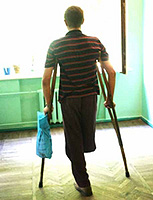 After the amputation of the lower limb, with a satisfactory overall state from the 3-4th day, the patient can take a vertical position. Therapeutic gymnastics is aimed at training the equilibrium and repair of a healthy leg. Along with overall exercises, perform movements with a load on a healthy leg, the vestibular apparatus is trained, exercise in equilibrium.
After the amputation of the lower limb, with a satisfactory overall state from the 3-4th day, the patient can take a vertical position. Therapeutic gymnastics is aimed at training the equilibrium and repair of a healthy leg. Along with overall exercises, perform movements with a load on a healthy leg, the vestibular apparatus is trained, exercise in equilibrium.
With one-sided amputation, patients study walking with two crutches, with a bilateral - independent transition to a carriage and movement in it. The formation of motor skills has a positive effect on the patient's psyche and facilitates care for it.
After removing the seams, therapeutic gymnastics is aimed at preparing a cultivation to prosthetics. To do this, it is necessary to restore mobility in the proximal joint, normalize the muscle tone in the cult, strengthen muscle groups that produce movements in the joint, prepare the advanced segments of limbs and torso to the mechanical effects of the sleeve, fasteners and drainage of prostheses, improve the muscular and articular feeling and coordination of combined movements and coordinates active relaxation, improve the forms of motor compensation.
The restoration of mobility in the preserved joints of the amputated limb is of paramount importance. As pain decreases, increasing mobility in the preserved joint, in classes include exercises to strengthen the muscles of the cult.
When the shin is amputate, for example, the knee-slander extensors should be strengthened, with hip amputations - extensors and discharge muscles of the hip joint. In the development of the muscular-articular sense and coordination of the movement, not so much the exercise is important, how much method of its implementation. For example, the lead in the shoulder joint can be used to increase mobility in it (dynamic free fly exercises), for the development of muscle strength (exercise with burdens, resistance), to train the muscular and articular sense (accurate reproduction of a given amplitude without vision control). Much attention should be paid to the development of skills in self-service of the cultures using devices, the simplest of which is a rubber cuff, worn on the cult. Under the cuff is inserted with a pencil, a spoon, fork and t. D.
After amputation of the limbs, posture defects may develop, so you need to use corrective exercises that take into account the characteristic changes in posture.
After the amputation of the upper limb, there is a shift of the adapter on the side of amputation up and forward, as well as the development of so-called walled blades. In this regard, against the background of general arraying exercises for the shoulder belt, it is necessary to use corrective movements aimed at lowering the adapters on the amputation side, performed both independently and in combination with the slope of the body, and movement aimed at minimizing the blades.
After the amputation of the lower limb, the state status is significantly violated, T. E. The center of gravity moves towards the surviving limb, which causes changes in the volunteer voltage of the neuromuscular apparatus necessary to preserve the equilibrium.
The consequence of this is the slope of the pelvis aside, where there is no support, persistent and if there is a prosthesis. The slope of the pelvis, in turn, entails the curvature of the spine in the frontal plane.
With amputation of both lower extremities to preserve equilibrium, a compensatory increase in the physiological bends of the spine. Exercise, being a means of active correction, eliminate the curvature of the spine due to strengthening the stretched muscles on the side of the convexity and stretching the contragated muscles on the concave side of the spinal deformation. Strengthening the muscles of the abdominal wall and the buttock muscles reduces the slope of the pelvis and changes the degree of bends of the spine.
Overloading a healthy limb, in particular, the foot of the foot, leads to the development of flatfoot, so it is advisable to use exercises aimed at strengthening and developing a neuromuscular foot apparatus. To training standing and walking on therapeutic and training prosthesis, start 3-4 weeks after surgery. When using temporary prostheses, motor skills are produced, facilitating the transition to walking on constant prostheses. Walking on therapeutic and training prosthesis has a positive effect on the cult, accelerating its formation.
Exercises
Source position - lying on the back:
- Flexion and extension in the ankle joint of a healthy leg (10-12 times).
- Flexing legs with the help of hands to contact the thighs with belly (3-5 times).
- The transition to the sitting position, followed by the tilt forward to the contact of the hands with your fingers (3-4 times).
- Imitation kicking ride. AND. NS. - Sitting on the floor.
- Rotate and slope of the body toward the cult with a support for hands (3-6 times).
- Raise the cult and blend the shin using hands (6-8 times).
Source position - lying on a healthy side:
- Decayment in the hip joint (5-8 times).
- Rimming the body with a support on hand (4-6 times).
- Rising foot.
Source position - lying on the stomach:
- Flexion of legs in the knee joints (6-8 times).
- Alternate extension of legs in hip joints (4-6 times).
- Hands to the sides (forward) - the extension of the body (4-6 times).
Source position - standing (holding the bed behind the chair or back):
- Squat (4-6 times).
- Lifting on the sock and roll on the heel (6-8 times).
- Decayment back (6-8 times).
- Fixing equilibrium, standing on foot with different hands.
Gymnastics after prosthetics
After supplying the upper limbs with the treatment, therapeutic gymnastics is aimed at developing the skills of using the prostheses. The shape and nature of the movements necessary for one or another skill are due to the type of prosthesis. The methodology of learning should be respected by a certain sequence. First of all, the patient must learn to wear and remove the prosthesis. When performing the movement, the proximal joint is first turned on, and then distal, for example, lifting the prosthesis (prostheses) to the sides, forward, bringing the brush prosthesis to mouth.
When teaching with protesters, the initial position of the body has an important meaning. So, first it is advisable to teach the taking and retention of objects, then sitting, from the edge of the table and directly from the table.
In addition to gymnastic exercises, elementary work therapist operations, mastering household skills and self-service.
After supplying the lower limbs with the protesters, it is necessary to start learning sick walking on the prostheses. At all stages of training on prostheses, the total tasks are: adaptation to the prosthesis, the strengthening of the muscles of the pelvis and the cult, training management prosthesis, training coordination, elimination of a truncated finiteness contractures, strengthening and relaxing the muscles of the preserved limb, orientation training in space. Private tasks depend on the stage of learning to move.
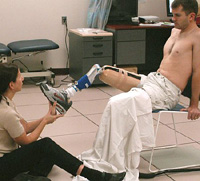 In the first stage, standing with a uniform support on both limbs, transfer the body weight in the front plane and standing on the prosthesis. In the second stage, the body weight is transferred in the sagittal plane, conduct training of the support and portable phases of the prosthetized and surviving limbs, work out the combined transfer of body weight to the prosthetic limb at the time of extension of the shin of the prosthesis.
In the first stage, standing with a uniform support on both limbs, transfer the body weight in the front plane and standing on the prosthesis. In the second stage, the body weight is transferred in the sagittal plane, conduct training of the support and portable phases of the prosthetized and surviving limbs, work out the combined transfer of body weight to the prosthetic limb at the time of extension of the shin of the prosthesis.
In the third stage, uniform stepper movements and rhythmic coordinated gait with the same promotion forward. Patients are mastering walking along the inclined plane, turns in walking, walking with overcoming obstacles, walking on the stairs and rough terrain. In addition to the main exercises, the elements of volleyball, basketball, badminton, table tennis, special exercises on the sports wall and the rowing simulator.
Improvement of the amputation method and prosthetics development led to the creation of a new method, which is named with prosthetics on the operating table, or express prosthetics.
The main advantage of this method with lower limb amputations - rehabilitation of rehabilitation. Early walking on the medical and training prosthesis (the first days after the operation) contributes to a faster adaptation of the patient to new living conditions, the formation of a new motor stereotype, has a positive effect on the patient's psyche.
The start of walking on the prosthesis depends on the overall state of the patient, traumatic operation, the intensity of pain and T. D. It is advisable to start walking on the prosthesis no later than 3 days after the operation. The first 1-2 days of patients go with the help of crutches, slightly coming on the prosthesis, 5-10 minutes 2 times a day. In the following days, the duration of walking and the load on the prosthesis increase.
By the 7th day you can replace crosses. After 2-3 weeks impose a permanent prosthesis. The tasks and methods of therapeutic gymnastics in express prosthetics correspond to the above described above, with ordinary prosthetics.

